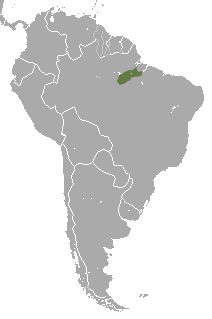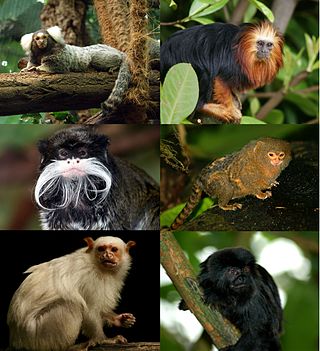
The Callitrichidae are a family of New World monkeys, including marmosets, tamarins, and lion tamarins. At times, this group of animals has been regarded as a subfamily, called the Callitrichinae, of the family Cebidae.

The marmosets, also known as zaris or sagoin, are twenty-two New World monkey species of the genera Callithrix, Cebuella, Callibella, and Mico. All four genera are part of the biological family Callitrichidae. The term "marmoset" is also used in reference to Goeldi's marmoset, Callimico goeldii, which is closely related.

Pygmy marmosets are two species of small New World monkeys in the genus Cebuella. They are native to rainforests of the western Amazon Basin in South America. These primates are notable for being the smallest monkeys in the world, at just over 100 g (3.5 oz). They are generally found in evergreen and river-edge forests and are gum-feeding specialists, or gummivores.

The black-tailed marmoset is a species of New World monkey from central South America, where it ranges from the south-central Amazon in Brazil, south through the Pantanal and eastern Bolivia, to the Chaco in far northern Paraguay. It is the southernmost member of the genus Mico and the only species where most of its range is outside the Amazon.

The buffy-tufted marmoset, also known as the buffy tufted-ear marmoset or white-eared marmoset, is a New World monkey that lives in the forests on the Atlantic coast of southeast Brazil. Of all the marmosets, it has the southernmost range.
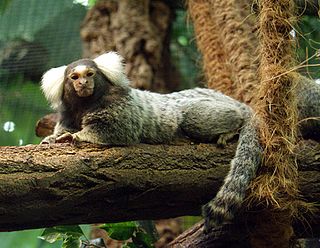
The common marmoset, also called white-tufted marmoset or white-tufted-ear marmoset, is a New World monkey. It originally lived on the northeastern coast of Brazil, in the states of Piaui, Paraiba, Ceará, Rio Grande do Norte, Pernambuco, Alagoas, and Bahia. Through release of captive individuals, it has expanded its range since the 1920s to Southeast Brazil, where it became an invasive species, raising concerns about genetic pollution of similar species, such as the buffy-tufted marmoset, and predation upon bird nestlings and eggs.

The black-tufted marmoset, also known as Mico-estrela in Portuguese, is a species of New World monkey that lives primarily in the Neo-tropical gallery forests of the Brazilian Central Plateau. It ranges from Bahia to Paraná, and as far inland as Goiás, between 14 and 25 degrees south of the equator, and can commonly be seen in the City of Rio de Janeiro where it was introduced. This marmoset typically resides in rainforests, living an arboreal life high in the trees, but below the canopy. They are only rarely spotted near the ground.

The Santarem marmoset, also known as the black and white tassel-ear marmoset, is a marmoset endemic to the Brazilian states of Amazonas and Pará.

The Maués marmoset is a marmoset endemic to Brazil. It is found only on the west bank of the Maués Açu River, in the Amazonas state.

The Emilia's marmoset, also known as Snethlage's marmoset, is a marmoset endemic to Brazil. It is found only in the Brazilian states of Pará and Mato Grosso. It was named to honour German-born Brazilian ornithologist Emilie Snethlage.

The gold-and-white marmoset, also known as the golden-white tassel-ear marmoset, is a species of marmoset, a small monkey endemic to the Amazon rainforest in eastern Amazonas state, Brazil.

The Hershkovitz's marmoset, also known as the Aripuanã marmoset is a marmoset species endemic to the south-central Amazon rainforest in Brazil. The common name is a reference to American zoologist Philip Hershkovitz.
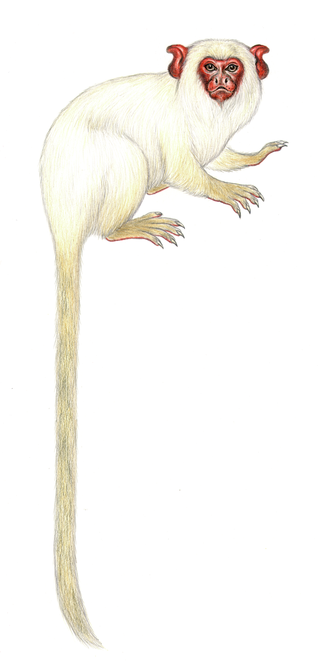
The white marmoset, or golden-white bare-ear marmoset, is a species of marmoset, a small monkey endemic to the Amazon rainforest in Pará, Brazil.

The Marca's marmoset is a species of marmoset that is endemic to the Amazon, in the Aripuanã-Manicoré interfluvium in Brazil. Its body is light grey, with orange legs, a black tail, a pinkish face, and naked ears. It is about 9 inches (23 cm) long, excluding the tail, and it has a 15-inch (38 cm) long tail. It weighs about 12 ounces (340 g).

The black-headed marmoset is a marmoset species endemic to Brazil. It inhabits humid tropical rainforest, mostly second growth and edge; the distribution is not exactly known but is thought to be Rio dos Marmelos in the north and east, Madeira River in the west and Ji-Paraná River in the south.

The Satéré marmoset is a marmoset species endemic to Brazil.
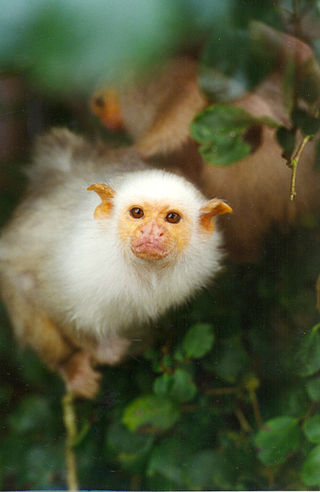
Mico is a genus of New World monkeys of the family Callitrichidae, the family containing marmosets and tamarins. The genus was formerly considered a subgenus of the genus Callithrix.

Callithrix is a genus of New World monkeys of the family Callitrichidae, the family containing marmosets and tamarins. The genus contains the Atlantic Forest marmosets. The name Callithrix is derived from the Greek words kallos, meaning beautiful, and thrix, meaning hair.

The western pygmy marmoset is a marmoset species, a very small New World monkey found in the northwestern Amazon rainforest in Brazil, Colombia, Ecuador, and Peru. It was formerly regarded as conspecific with the similar eastern pygmy marmoset, which has whitish underparts. Although the western pygmy marmoset occurs further west than the eastern pygmy marmoset, the primary separators of their ranges are the Amazon River and Marañón River, with the western occurring to the north of them and the eastern to the south.
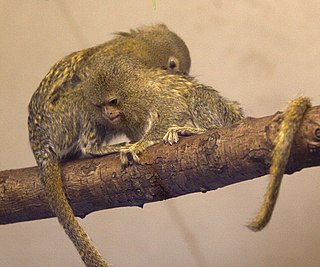
The eastern pygmy marmoset is a marmoset species, a very small New World monkey, found in the southwestern Amazon Rainforest in Bolivia, Brazil, Ecuador, and Peru. It was formerly regarded as conspecific with the similar western pygmy marmoset, but the eastern pygmy marmoset has whitish colored underparts. Although the eastern pygmy marmoset occurs further east than the western pygmy marmoset, the primary separators of their ranges are the Amazon River and Maranon River, with the western occurring to the north of them and the eastern to the south. The species has recently been confirmed by DNA testing to exist in Ecuador, hundreds of kilometers north of the Maranon River.

